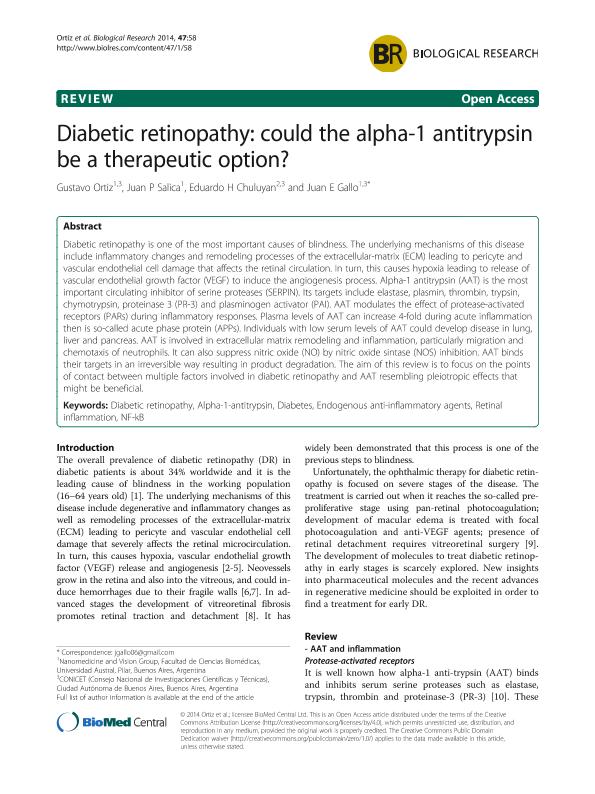Artículo
Diabetic retinopathy: could the alpha-1 antitrypsin be a therapeutic option?
Fecha de publicación:
11/2014
Editorial:
BioMed Central
Revista:
Biological Research
ISSN:
0716-9760
e-ISSN:
0717-6287
Idioma:
Inglés
Tipo de recurso:
Artículo publicado
Clasificación temática:
Resumen
Diabetic retinopathy is one of the most important causes of blindness. The underlying mechanisms of this disease include inflammatory changes and remodeling processes of the extracellular-matrix (ECM) leading to pericyte and vascular endothelial cell damage that affects the retinal circulation. In turn, this causes hypoxia leading to release of vascular endothelial growth factor (VEGF) to induce the angiogenesis process. Alpha-1 antitrypsin (AAT) is the most important circulating inhibitor of serine proteases (SERPIN). Its targets include elastase, plasmin, thrombin, trypsin, chymotrypsin, proteinase 3 (PR-3) and plasminogen activator (PAI). AAT modulates the effect of protease-activated receptors (PARs) during inflammatory responses. Plasma levels of AAT can increase 4-fold during acute inflammation then is so-called acute phase protein (APPs). Individuals with low serum levels of AAT could develop disease in lung, liver and pancreas. AAT is involved in extracellular matrix remodeling and inflammation, particularly migration and chemotaxis of neutrophils. It can also suppress nitric oxide (NO) by nitric oxide sintase (NOS) inhibition. AAT binds their targets in an irreversible way resulting in product degradation. The aim of this review is to focus on the points of contact between multiple factors involved in diabetic retinopathy and AAT resembling pleiotropic effects that might be beneficial.
Palabras clave:
Diabetes
,
Diabetic Retinopathy
,
Alpha-1-Antitrypsin
,
Retinal Inflammation
Archivos asociados
Licencia
Identificadores
Colecciones
Articulos(CEFYBO)
Articulos de CENTRO DE ESTUDIOS FARMACOLOGICOS Y BOTANICOS
Articulos de CENTRO DE ESTUDIOS FARMACOLOGICOS Y BOTANICOS
Articulos(SEDE CENTRAL)
Articulos de SEDE CENTRAL
Articulos de SEDE CENTRAL
Citación
Ortiz, Gustavo Alfredo; Salica, Juan Pablo; Chuluyan, Hector Eduardo; Gallo, Juan Eduardo Maria; Diabetic retinopathy: could the alpha-1 antitrypsin be a therapeutic option?; BioMed Central; Biological Research; 47; 11-2014; 58-67
Compartir
Altmétricas




